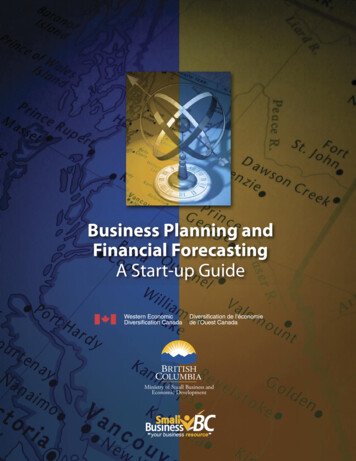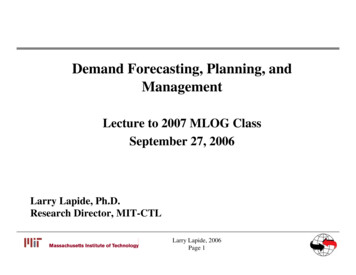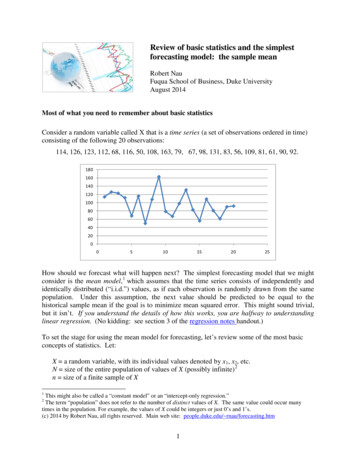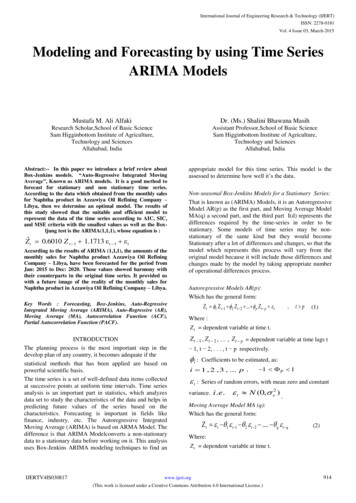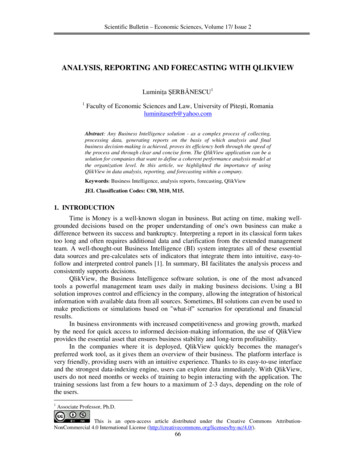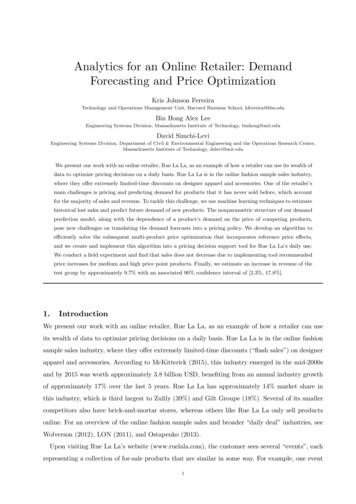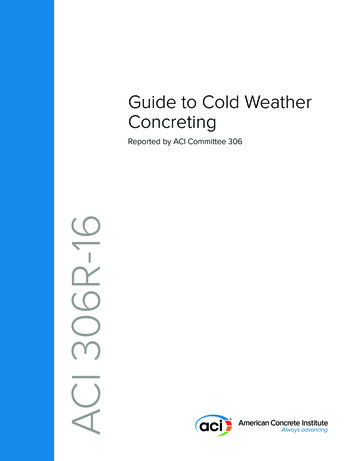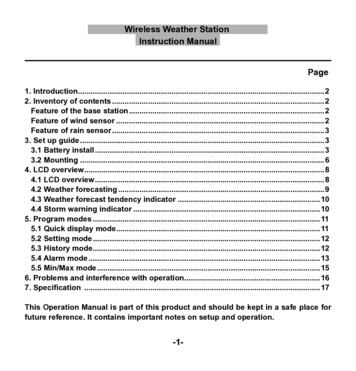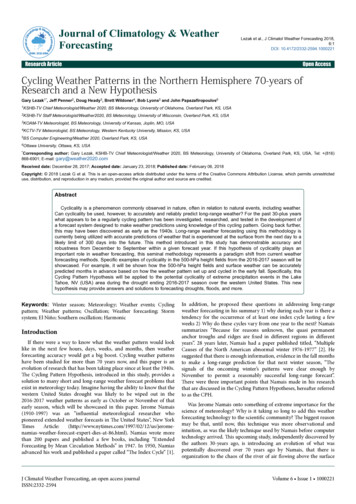
Transcription
gy & Weaolotatl ofurna ClimJorecastinr FogheJournal of Climatology & WeatherForecastingLezak et al., J Climatol Weather Forecasting 2018,6:1DOI: 10.4172/2332-2594.1000221ISSN: 2332-2594Research ArticleOpen AccessCycling Weather Patterns in the Northern Hemisphere 70-years ofResearch and a New HypothesisGary Lezak1*, Jeff Penner2, Doug Heady3, Brett Wildoner4, Bob Lyons5 and John Papazafiropoulos61KSHB-TVChief Meteorologist/Weather 2020, BS Meteorology, University of Oklahoma, Overland Park, KS, USA2KSHB-TVStaff Meteorologist/Weather2020, BS Meteorology, University of Wisconsin, Overland Park, KS, USA3KOAM-TV4KCTV-TV5BSMeteorologist, BS Meteorology, University of Kansas, Joplin, MO, USAMeteorologist, BS Meteorology, Western Kentucky University, Mission, KS, USAComputer Engineering/Weather 2020, Overland Park, KS, USA6OttawaUniversity, Ottawa, KS, USA*Correspondingauthor: Gary Lezak, KSHB-TV Chief Meteorologist/Weather 2020, BS Meteorology, University of Oklahoma, Overland Park, KS, USA, Tel: (816)868-6901; E-mail: gary@weather2020.comReceived date: December 28, 2017; Accepted date: January 23, 2018; Published date: February 06, 2018Copyright: 2018 Lezak G et al. This is an open-access article distributed under the terms of the Creative Commons Attribution License, which permits unrestricteduse, distribution, and reproduction in any medium, provided the original author and source are credited.AbstractCyclicality is a phenomenon commonly observed in nature, often in relation to natural events, including weather.Can cyclicality be used, however, to accurately and reliably predict long-range weather? For the past 30-plus yearswhat appears to be a regularly cycling pattern has been investigated, researched, and tested in the development ofa forecast system designed to make weather predictions using knowledge of this cycling pattern. Going back further,this may have been discovered as early as the 1940s. Long-range weather forecasting using this methodology iscurrently being utilized with accurate predictions of weather that is experienced at the surface from the next day to alikely limit of 300 days into the future. This method introduced in this study has demonstrable accuracy androbustness from December to September within a given forecast year. If this hypothesis of cyclicality plays animportant role in weather forecasting, this seminal methodology represents a paradigm shift from current weatherforecasting methods. Specific examples of cyclicality in the 500-hPa height fields from the 2016-2017 season will beshowcased. For example, it will be shown how the 500-hPa height fields and surface weather can be accuratelypredicted months in advance based on how the weather pattern set up and cycled in the early fall. Specifically, thisCycling Pattern Hypothesis will be applied to the potential cyclicality of extreme precipitation events in the LakeTahoe, NV (USA) area during the drought ending 2016-2017 season over the western United States. This newhypothesis may provide answers and solutions to forecasting droughts, floods, and more.Keywords: Winter season; Meteorology; Weather events; Cyclingpattern; Weather patterns; Oscillation; Weather forecasting; Stormsystem; El Niño; Southern oscillation; HarmonicIntroductionIf there were a way to know what the weather pattern would looklike in the next few hours, days, weeks, and months, then weatherforecasting accuracy would get a big boost. Cycling weather patternshave been studied for more than 70 years now, and this paper is anevolution of research that has been taking place since at least the 1940s.The Cycling Pattern Hypothesis, introduced in this study, provides asolution to many short and long-range weather forecast problems thatexist in meteorology today. Imagine having the ability to know that thewestern United States drought was likely to be wiped out in the2016-2017 weather patterns as early as October or November of thatearly season, which will be showcased in this paper. Jerome Namais(1910-1997) was an “influential meteorological researcher whopioneered extended weather forecasts in The United States”, New 86.html). Namias wrote morethan 200 papers and published a few books, including “ExtendedForecasting by Mean Circulation Methods” in 1947. In 1950, Namiasadvanced his work and published a paper called “The Index Cycle” [1].J Climatol Weather Forecasting, an open access journalISSN:2332-2594In addition, he proposed these questions in addressing long-rangeweather forecasting in his summary 1) why during each year is there atendency for the occurrence of at least one index cycle lasting a fewweeks 2) Why do these cycles vary from one year to the next? Namaissummarizes “Because for reasons unknown, the quasi permanentanchor troughs and ridges are fixed in different regions in differentyears”. 28 years later, Namais had a paper published titled, “MultipleCauses of the North American abnormal winter 1976-1977” [2]. Hesuggested that there is enough information, evidence in the fall monthsto make a long-range prediction for that next winter season, “Thesignals of the oncoming winter’s patterns were clear enough byNovember to permit a reasonably successful long-range forecast”.There were three important points that Namais made in his researchthat are discussed in the Cycling Pattern Hypotheses, hereafter referredto as the CPH.Was Jerome Namais onto something of extreme importance for thescience of meteorology? Why is it taking so long to add this weatherforecasting technology to the scientific community? The biggest reasonmay be that, until now, this technique was more observational andintuition, as was the likely technique used by Namais before computertechnology arrived. This upcoming study, independently discovered bythe authors 30-years ago, is introducing an evolution of what waspotentially discovered over 70 years ago by Namais, that there isorganization to the chaos of the river of air flowing above the surfaceVolume 6 Issue 1 1000221
Citation:Lezak G, Penner J, Heady D, Wildoner B, Lyons B, et al. (2018) Cycling Weather Patterns in the Northern Hemisphere 70-years ofResearch and a New Hypothesis. J Climatol Weather Forecasting 6: 221. doi:10.4172/2332-2594.1000221Page 2 of 11in the troposphere; a cycling pattern that repeats. It will be presentedand shown that the qualitative work can now be quantified withaccurate results.The science of weather forecasting has evolved tremendously overthe past few decades. With all of the advances in the field ofmeteorology, it is widely believed that there is a 15-day limit in forecastskill. This has been cited in numerous papers [3]. Today, some forecastsdelivered by TV meteorologists go out seven to 12 days with a limitedamount of accuracy, while forecasts with three days to a week of leadtime barely had any skill a couple of decades ago. Indeed, the WeatherPrediction Center (WPC) three-day quantitative precipitation forecastsare as accurate today as one-day forecasts were around 20 years ago[4]. The same article also notes that MOS mean absolute errors forseven-day temperature forecasts in 2012 were the same as they were fora three-day forecast in the early 1980s (averaged over the CONUS).In addition to increased accuracy in weather forecasting in the oneto seven day range, there has been increased emphasis on improvingseasonal forecasts over the past couple of decades. For example,Colucci and Baumhefner examined the accuracy of 30-day 500-hPaheight anomaly forecasts [5]. The study determined that the accuracyof the 30-day forecasts was somewhat dependent on initial conditions.More recently, Gershunov et al. examined the year-to-year variabilityof atmospheric river events affecting the west coast of North America,citing several factors that influence their intensity [6]. Gensinianalyzed the predictability of tornado outbreaks two to three weeks inadvance using a combination of factors, notably the Global WindOscillation [6].While Gensini [6] focused on tornado outbreaks, this study aims todisplay a cycling pattern hypothesis that allows the operationalforecaster to predict not only tornado outbreaks, but also otherpotential significant weather events weeks to months in advance. ThisCPH technology may very well help businesses and consumers planand prepare with confidence.There appears to be evidence cyclicality plays a significant role inthe weather we experience here on earth. There are many possiblecauses of this cyclicality: sea surface temperature anomalies, the tilt ofthe earth’s axis, temperature anomalies of the air masses, and acombination of other forcing mechanisms still being identified.Cycling patterns have been studied over the past few decades.The Madden-Julian Oscillation (MJO), which has been accepted inthe scientific community, shows that there is a cycling pattern ofincoming and outgoing long-wave radiation, which is showcased byconvective complexes within the tropical regions of the earth. In 1971,Roland Madden and Paul Julian stumbled upon a 40-50 day oscillationwhen analyzing zonal wind anomalies in the tropical Pacific [7]. TheMJO, also referred to as the 30-60 day oscillation, turns out to be themain intra-annual fluctuation that explains weather variations in thetropics. From Matthews [8], “accurate forecasting of this variability willbenefit people living in the tropical regions, and also over the rest ofthe Earth due to remote ‘teleconnections’ between the weather in thetropics and the weather elsewhere around the globe.” It is accepted thatthere is a cycling pattern within the tropics. Why wouldn’t the patternalso be cycling regularly within the westerly belt?In addition to the MJO, other oscillations have been studied fordecades and are currently being analyzed today, such as the ArcticOscillation (AO), North Atlantic Oscillation (NAO), Pacific DecadalOscillation (PDO), and many more. More details about theseteleconnections can be found on the NOAA CPC website. TheseJ Climatol Weather Forecasting, an open access journalISSN:2332-2594teleconnections have shown some cyclicality as well, but with littleknown predictability. The weather forecaster that uses a growingunderstanding of all of these parameters, combined with knowledge ofwhat is being presenting in the CPH, will be able to develop some skillin forecasting the weather beyond 15 days.While Namais may have discovered something rather significant inthe 1940s and 1950s, this paper is a proposed advancement of Namais’work.The cycling pattern hypothesis (CPH); there are three mainaspects to this new hypothesis A unique weather pattern within the troposphere, evolves anddevelops every year in the early fall, roughly between around 1October and 30 November.Long-term long-wave troughs and ridges become established,called quasi-permanent anchor troughs and ridges by Namais.These features develop over the Northern Hemisphere every falland are in different locations each year. These broad synoptic scalefeatures, seen in the 500-hPa charts, are where storm systems reachtheir peak strength, near the anchor troughs, and they are mostoften at their weakest near the anchor ridges, and line up indifferent positions in each cycling pattern year. The smallerfeatures, the short wave troughs, vorticity maximums, etc. areinfluenced by how these anchor troughs and ridges set up eachyear. These smaller features have been found to also be unique tothat current years pattern and important factors to understand tohelp make accurate weather predictions for what is experienced atthe surface.A cycle length evolves, becomes established by sometime inDecember each year, and then the cycle and pattern continue in aregular range through the rest of fall, winter, spring, and summer.In the 2016-2017 season the pattern was likely cycling in a 56 to 61day range, centered on 58.5 days; i.e. if the first cycle is 58.5 days inlength, then the second cycle will also be in that range and repeat.The entire cycle has been observed to repeat over and over againuntil the new pattern sets up the next October.In studying and analyzing the weather patterns of the past fewdecades, it has been observed, by the authors of this paper, that aunique weather pattern sets up each fall, and this beginning of eachyear’s cycling pattern happens to coincide within just two weeks of thesun setting at the North Pole, about the time twilight ends and totaldarkness begins. There may be some connection to this, seemingly,coincidence, and it must be explored further in future studies. Theweather pattern seems to begin each fall right around the same timethe North Pole twilight ends.The second aspect of the CPH is highly important for seasonalforecasting and so much more. Synoptic scale storm systems will reachpeak strength and intensify into anchor troughs and weaken as theyapproach the anchor ridges. The locations near these long term longwave features will be affected by an above average number of stormsystems near the anchor troughs, with a below average number ofstorm systems within a given season near the anchor ridges.The third aspect of the CPH is perhaps of the utmost importance; acycle length evolves, becomes established, and continues through thenext summer. Once the cycle length is identified, if it is truly cyclingwithin the identified range in that year’s pattern, it can then be used tomake rather specific weather forecasts down to a series of dates. If theforecaster has knowledge of the cycle length, then the part of theVolume 6 Issue 1 1000221
Citation:Lezak G, Penner J, Heady D, Wildoner B, Lyons B, et al. (2018) Cycling Weather Patterns in the Northern Hemisphere 70-years ofResearch and a New Hypothesis. J Climatol Weather Forecasting 6: 221. doi:10.4172/2332-2594.1000221Page 3 of 11pattern that produces impacting storm systems can be predicted toreturn on cycle, and accurate weather predictions can be made. Broadseasonal forecasts for regions would be made with the potential ofbeing accurate. For the forecast to be more specific, knowledge of howthe 500-hPa flow will affect other significant levels down to the surfacewill need to be applied and tested. For example; if a city is affected by along-term long-wave 500 hPa trough and thus experiences a largenumber of storm systems in October and November, one canconfidently make a winter forecast for below average temperatures andabove average precipitation. To identify specific high-impact stormsystems in advance using only the 500hPa flow, the forecaster mustcarefully analyze each 500hPa wave that occurred during October/November and figure out how each wave will affect other significantlevels (e.g. 925, 850, and 700hPa) as well as the surface weather. Eventhough the 500-hPa pattern is likely cycling regularly, forecasts forsurface weather with months of lead-time will sometimes be off by afew days or a few hundred miles.Once a cycle is established, the entire cycle will then repeat over andover again until another unique pattern sets up the next fall. Accordingto the CPH, the current year’s pattern fades, and the new patternevolves and begins during a transition period near the end ofSeptember into early October. This limits the forecast accuracy to befrom December through the next September and not beyondSeptember, or around a 300-day limit in accuracy.The CPH has been in use for the past 15-plus years with resultsbeing analyzed and tested. The cycle length, during the 2016-2017seasons, became established in October and November as proposed bythe CPH, and then continued through the rest of fall, winter, spring,and through the following summer in 2017. This study will show, bothquantitatively and qualitatively, that a 56 to 61 day cycle becameestablished by December in the 2016-2017 cycling pattern year. Thecyclicality will be tested using a cycle length near the average of eachrange; i.e. 58.5-days in the 2016-2017 season. A cycling pattern yearwill be defined to be from 1 October of the current year to 30September of the following year.The meteorologist observing the cycling weather pattern will havethe ability to pick out and identify the storm systems that will likelyreturn in future cycles. This is done by analyzing upper level chartswithin the troposphere (mainly at the 500-hPa level) and then usingthe cycle length to project into the future, as was possibly a Namaistechnique in the 1940s and 1950s. The 500-hPa level was chosenbecause it is, on average, over 1000 meters above the highestmountains in the CONUS. Thus, topography at the surface will haveminimal effects on the 500-hPa height field. The quantitative analysiswill be presented as it uses this essential information, validating thelikely cycle length and applying it to the forecast system. If thequalitative analysis matches the quantitative verification, then themodel will have an increased chance of being accurate and the weatherforecaster will gain confidence without even needing a computermodel to help make a future forecast. The 500 hPa pattern over a fewdays can be projected into future cycles and then forecasts will bemade for any location chosen in the Northern Hemisphere.Over the past 15 years, the CPH has been documented (shownbelow) with cycle lengths identified by mid-December each year.Utilizing knowledge of this innovative forecast method, hundreds offorecasts have been made, many of them quite accurate, while otherforecasts failed. What has also been observed is that the cycling patternitself rarely ever fails; i.e. the pattern has been shown to always becycling in the ranges identified. The inaccurate forecasts come from theJ Climatol Weather Forecasting, an open access journalISSN:2332-2594weather forecaster that is attempting to use the CPH in making theseweather predictions, and then the storm ends up arriving, but it mayjust miss the forecast verification site. Forecasting low-level jets andother features that will impact weather events must be considered.Having a strong understanding of how the flow is analyzed at the 500hPa level can be used to forecast how features at other significant levelswill line up, and this will increase the probability of a successfulforecast. Examples of the CPH were found through qualitative analysisof the 500-hPa maps. Later in this paper, we will show the qualitativeanalysis from the 2016-2017 season, and quantitative validation fromthree CPH years. Here are the cycle lengths that were documentedthrough observational analysis in recent years: 2002-2003: 35 to 40 days (37.5 day average)2003-2004: 52 to 56 days (54 day average)2004-2005: 73 to 77 days (75 day average)2005-2006: 60 to 62 days (61 day average)2006-2007: 42 to 48 days (45 day average)2007-2008: 52 to 54 days (53 day average)2008-2009: 50 to 53 days (51.5 day average)2009-2010: 58 to 62 days (60 day average)2010-2011: 50 to 52 days (51 day average)2011-2012: 45 to 49 days (47 day average)2012-2013: 50 to 57 days (53.5 day average)2013-2014: 55 - 61 days (58 day average)2014-2015: 43 to 50 days (46.5 day average)2015-2016: 47 to 52 days (49.5 day average)2016-2017: 56 to 61 days (58.5 day average)During the past 30 years, a long-range forecasting system has beendeveloped and having an understanding of the cycle length is essentialwhen making weather forecasts based on this new hypothesis. We willscientifically examine this evolving system to establish the validity tothis proposed methodology for weather prediction.Material and MethodA cycling pattern index and correlation coefficientTo validate, what is found qualitatively through map-to-mapcomparisons, a quantitative analysis of the 500-hPa height fields forvarious locations has been completed. One metric that is beingdeveloped and tested to showcase the cycling of the 500-hPa heightsare the Cycling Pattern Index (CPI), and another 500-hPa analysis, thathas been named, the Eastern Pac
Forecasting by Mean Circulation Methods” in 1947. In 1950, Namias advanced his work and published a paper called “The Index Cycle” [1]. In addition, he proposed these questions in addressing long-range weather forecasting in his summary 1) why during each year is there a tendency for
